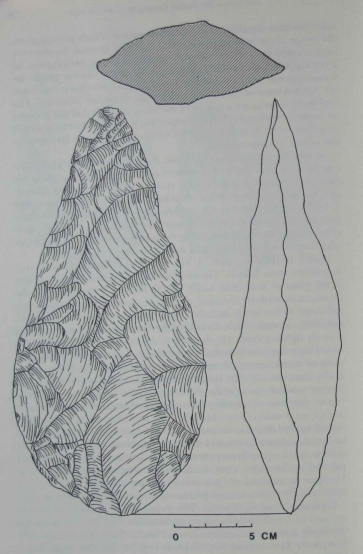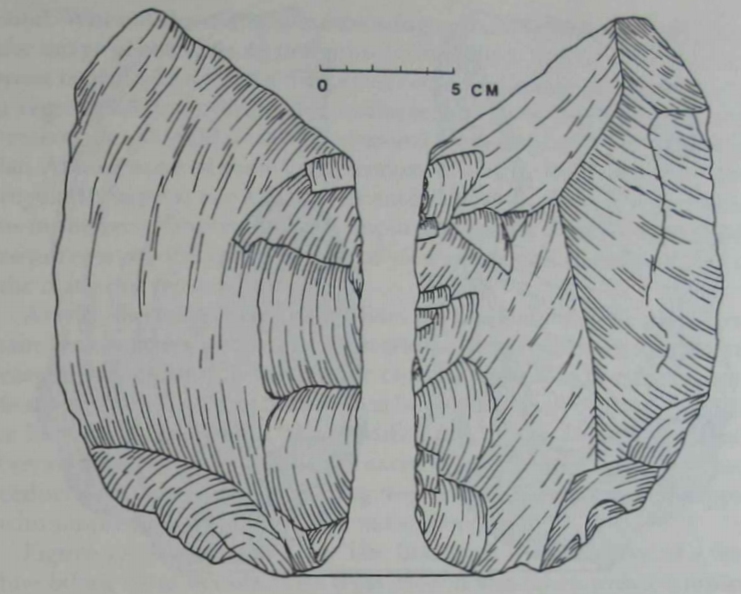| Definition |
p. 28 |
The cross section of an object is the two-dimensional shape produced by a plane intersecting the solid. For example, the cross section
of a sphere is a circle; of a cylinder, a circle or an ellipse; of a pyramid,
a rectangle. The cross section of a biface is the two-dimensional shape
produced by an imaginary plane intersecting the artifact. We say that
a biface has a "regular" cross section if it presents a recognizable twodimensional figure such as a rhombus or a triangle or a lens shape.
Symmetry is usually the most telling quality of regularity. |
| Imagination |
p. 28f. |
The ability to conceive of and create a regular cross section requires
a sophisticated coordination of viewpoints or perspectives. First, it is
necessary that the observer – in our case the knapper – be aware of a
viewpoint that is not actually available to him. One cannot sight into a solid. Without the aid of some assisting apparatus such as a template the image of the cross section must be imagined.
Second, the observer must coordinate a virtual infinity of cross sections or perspectives. |
Example
|
p. 29 |
| The cross section was taken with a template
at the point of maximum width. As can be seen from Figure 13, the
artifact is extensively trimmed, and it is fair to conclude that the original shape of the blank, including the cross section, has been changed.
Could the knapper have controlled the shape of this cross section by
directly sighting from a perspective to the rear of the artifact? Such a
direct sighting would actually combine (and confound) the dimensions of maximum width and maximum thickness, which do not fall
at the same point on the length of the artifact (maximum thickness is
farther toward the tip). In other words, the knapper would see a
"view" that was a composite of two separate cross sections. |

|
There is,
in fact, no position from which the cross section of the artifact in Figure 13 can be directly observed. It must be created in the imagination
or, as I have done, measured with a device. Moreover, a planar intersection taken virtually anywhere on this artifact, even at angles not
parallel to the major axes, would yield a regular cross section. The
knapper constructed not just one imaginary viewpoint but a virtual
infinity of them. His control in this regard was quite remarkable.
|
| Reversal and congruency |
p. 51 |
[The item in Figure 13] is not only bilaterally symmetrical in plan, it is symmetrical
in profile and in all of its cross sections. Furthermore it is extensively
trimmed, and the shapes are certainly intentional. The symmetry is
extremely regular, and the mirrored shapes are congruent. One
could improve little on the result if one were to use a measuring device. The symmetries in this artifact come very close to fulfilling the
formal definition of symmetry. |
| End point of developmental sequence |
p. 52 |
The handaxe in Figure 13 also suggests something even more remarkable than simple bilateral symmetry. The artifact demonstrates
symmetry across not just a midline in plan, but also a midline in profile and a midline for all of the cross sections. These lines intersect to
define a three-dimensional space, intuitively equivalent to a space of
Cartesian coordinates. It is difficult to imagine how a more sophisticated conception of space could be employed in stone knapping. Artifacts like this one constitute the endpoint of our developmental
sequence. |
| Three-dimensional frame of reference |
p. 57 |
The fine bifaces, like those in example 13, have
bilateral symmetry in three dimensions (as we would define them).
The knapper had to be able to invert
congruent shapes across an
imaginary midline for three separate dimensions and to coordinate
them. This required a frame of reference of considerable complexity,
and, while I suppose it possible that this frame was applied only to
spatial relations on or within artifacts, this seems to me very unlikely.
The abstract nature of such a spatial framework suggests that it was a
general one, extendable to all of space. Again I must emphasize that
the knapper need not have been able to describe or to verbalize his
concepts in nice mathematical terms. That he employed such a framework, however, is, I think, undeniable. |

